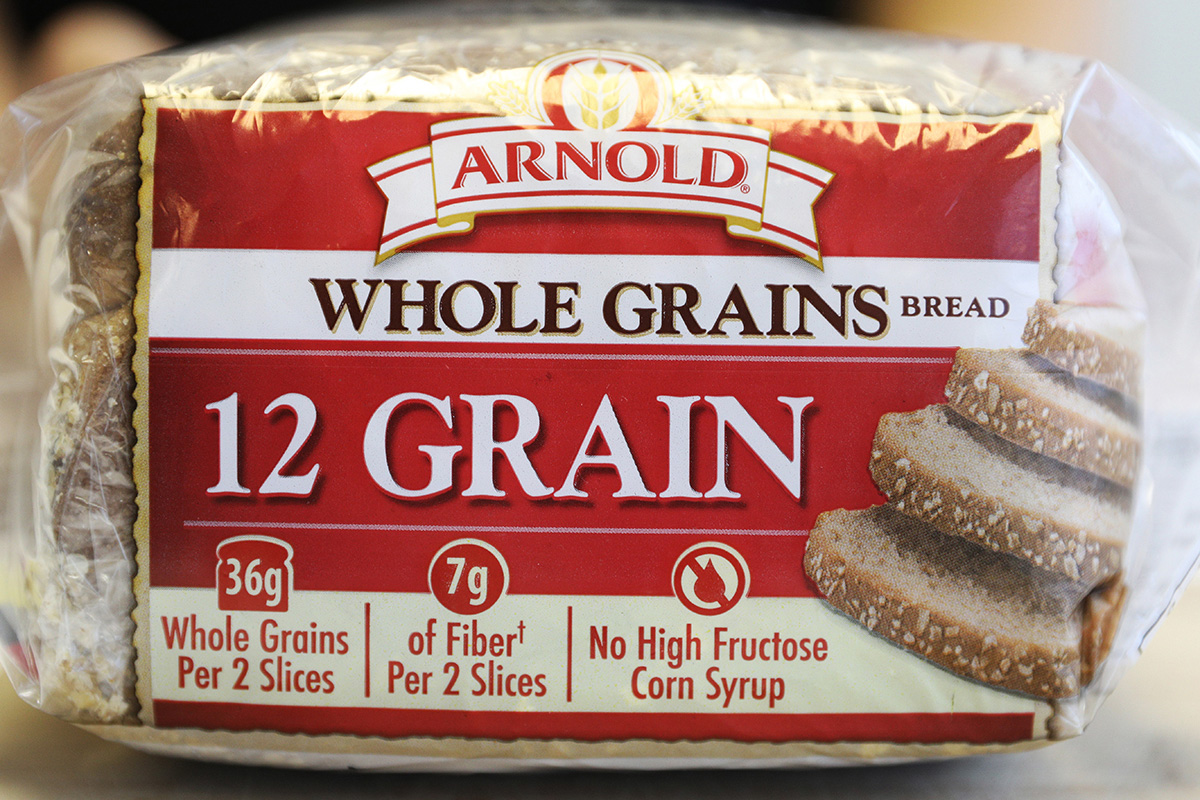Why Fancy Whole-Grain Bread is Good for Your Waistline AND Your Wallet

If you’re trying to eat healthy, some grocery store aisles are just trouble. The cookie aisle? A trap. The soda aisle? Avert your eyes and walk directly to the no-sugar-added seltzer.
The bread aisle? That can be a trap, too.
There’s no shortage of styles, flavors and shapes of bread on supermarket shelves. But a quick scan of their labels can be confusing. Whole wheat? Whole grains? Multigrain? “Made with” a bunch of stuff you should probably care about?
What is all this stuff? And why does it cost upward of $6?
In Defense of Bread
Let’s get one thing straight from the start: This is not a bread takedown. I am not here to vilify the same thing I will reliably lunge for when it gets dropped on my table.
Please, look at these dumb headlines I won’t even link to:
14 “Healthy” Foods That Are Actually Bad For You
5 Reasons Bread is the Enemy of Good Health
4 Reasons Why You Shouldn’t Eat Bread
Is Bread Healthy to Eat?
Last I checked, grains still occupied one-fourth of the food plate. Everybody, please calm it down. Gluten-averse individuals aside, we do not need to run from the bread aisle.
Sure, it’s still a trap, especially if you are a bread fanatic. But it’s not difficult to figure out how to get the biggest bang for your bread buck. You can continue to love bread and save money on “the good stuff.”
Ingredients, Shmingredients
Think all bread is basically the same? Not quite. Here’s what you may find advertised on bread packaging and ingredient lists.
Companies pump up enriched breads with nutrients they lose during the flour-refining process. However, the Whole Grains Council warns that enrichment doesn’t come close to making up for these lost nutrients.
When bread is advertised as whole wheat, it indicates the manufacturer ground the entire wheat grain to make the bread, Debra Brunk, owner of Radix Nutrition and Wellness in Arizona, explained.
“It’s more dense, but can still have a lot of additives,” she said.
(Full disclosure: Brunk is my personal nutritionist.)
Check the ingredient list, she advised: A “whole wheat” bread may contain other ingredients that prevent it from being 100% whole wheat.
Meanwhile, whole grain bread can be made with flour that’s not made from wheat – think oats, buckwheat or millet. To make the “whole grain” claim on the package, that whole grain must be the first item on the ingredient list. Additionally, none of the grains can be refined, resulting in a much heavier loaf.
“There’s more water because the whole grains soak it up to produce a denser bread,” Brunk said. These varieties are typically packed with more nutrients, she said.
To recap using a geometry lesson: Just like all squares are rectangles, but not all rectangles are squares, all whole wheat is whole grain, but not every whole grain is whole wheat.
Why You Should Start Reading Bread Labels

So you want a tasty bread option that still has some nutrients baked into it?
Start actually reading ingredient lists.
Why not just pay attention to the words on the front of the bag? Brunk admits that most front-of-the-bag claims are just marketing.
“There aren’t a lot of requirements from the government in terms of what goes into those (midrange breads),” Brunk said. “A label advertising ‘full of whole grains’ might not really be the case,” she warned.
Gayle Veum, a registered dietician and vice president of the Wheat Foods Council, agrees.
“Just because it says 12-grain, seven-grain, multigrain, there’s no guarantee of fiber or nutritional content,” she said.
Flipping a loaf over to check the calories and fiber content is key. If fiber (which provides that full, satisfied feeling) is what you’re looking for, Veum said 2-3 grams per slice is a good amount.
Brunk warns against picking a loaf of bread simply because it looks healthy.
“It’s not about the color,” she said. “You can tell a lot more by the weight. Reading the label of any food is key, but a lot of us don’t take the time to do that,” she said. “When you read a label, you only have to do it once. If you decide you like the product and want to buy it again, you might want to check the ingredients occasionally, but you don’t really have to do it again.”
The Healthiest Breads on a Budget

Hear me out, bread lovers.
Changing the way you eat bread can help you save — and maybe even trim your waistline.
When you eat a more nutrient-dense bread, Brunk explains, you don’t need as much of it to feel full. It also takes longer to digest, so you don’t crave a snack in an hour.
Brunk recalls how when she was a child, it was customary to eat two slices of toast with breakfast, have two slices as a sandwich at lunch and then have bread and butter on the table at dinner. Today’s food pyramid* — I’m sorry, food plate — relies less on grains and more on protein and vegetables.
Ezekiel bread with sprouted grains can cost $4-$6 per loaf, but it’s a favorite among health-conscious carb consumers.
“If a loaf of white bread costs $2 but you eat eight slices a day, you could spend twice as much on a loaf of Ezekiel bread but reduce your intake by half or more,” Brunk said.
“Sometimes you’re saving money (by buying less bread), and you’re feeding your body better stuff.”
How to Make the Most of Your Bread Budget
Looking for some easy ways to make the most of your bread budget?
Buy Day-Old Bread (Really!)
Don’t assume the day-old rack at the grocery store bakery means stale bread.
“Ask when bread is moved to that rack,” Veum said. She’s found that some stores move bread to the “day-old” rack as early as 6 p.m. on the same day it was baked.
“It’s a great place to save money on bread,” Veum says. “Sometimes it’s marked down 50%.”
That fresh (or nearly fresh) bread probably tastes better than that enriched bread designed to sit on the shelf for a month. However, Brunk warns these breads may contain rising agents so the store can bake more bread more quickly — and those agents can zap some of the nutrients during the baking process.
Plan Your Bread Purchases

Plan where you buy bread. If you want a loaf from a specialty bakery, of course you expect to pay more. But if you’re in a jam and end up grabbing a random loaf of bread from a convenience store, that ordinary loaf can suddenly cost as much as the freshly baked one you really enjoy.
Don’t be Swayed by the Smell of Fresh Bread at the Deli
“People will say a $4 or $5 loaf is expensive,” Veum says, “But compared to the cost of ordering a sandwich, it makes sense to brown-bag it” and make your own sandwiches — ones you’ll actually want to eat after lugging them to the office.
Freeze!
Want your loaf of bread to last longer? Don’t refrigerate it. It’ll dry out the bread, Veum says. She recommends putting a bagged loaf of bread inside a zipper bag and storing it in the freezer. Take it out slice by slice, and the loaf will last up to three months.
If you’re pulling a loaf from the fridge right now (no shame!), those less-than-fresh slices are still useful. You can soak them in batter for perfect French toast or cut them into small squares and bake for homemade croutons.
Don’t Forget to Stack Deals
The usual rules of maximizing your grocery store savings apply, whatever type of bread you crave. Look for store deals, manufacturer coupons and rebates to lower your final cost.
Your bread variety is a choice. Your entire diet is a choice. Saving? Well, that’s something we can all agree on.
* RIP food pyramid.
Lisa Rowan is a writer and producer at The Penny Hoarder. From ages 4 through 18, her primary food group was bread products (sorry, mom).












